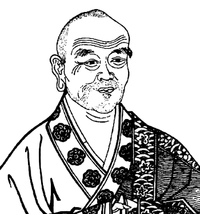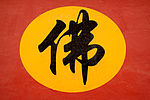Fotu Cheng
Fotudeng | |
|---|---|
 Illustration of Fotudeng from a Chinese print. | |
| Born | 231 CE |
| Died | 349 CE |
| Occupation(s) | Buddhist monk, scholar, political analyst and translator |
| Part of a series on |
| Chinese Buddhism |
|---|
 |
Fotudeng (Sanskrit: Buddhacinga?; simplified Chinese: 佛图澄; traditional Chinese: 佛圖澄; pinyin: Fótúdéng) (ca. 231-349 CE) was a Buddhist monk from Kucha. He studied in Kashmir and came to Luoyang in 310, and was active in the spread of Buddhism in China.
Life
Early life and emigration to China
Fotudeng came from Central Asia to China in 310 CE and propagated Buddhism widely. He is said to have demonstrated many spiritual powers, and was able to convert the warlords in this region of China over to Buddhism.[1] He succeeded in converting Shi Le and became his closest advisor as he founded the Later Zhao dynasty in 319. Fotudeng uttered the only phrase that reached us in the Jie language, cited in connection with the Shi Le fight against Liu Yao in 328 CE, and recorded in the Chinese annals with Chinese translation.[2] This phrase was analyzed in several publications.[3][4][5][6][7]
As a teacher of meditation
Fotudeng is well known for teaching methods of meditation, and especially ānāpānasmṛti ("mindfulness of breathing"). Fotudeng widely taught ānāpānasmṛti through methods of counting breaths, so as to temper to the breathing, simultaneously focusing the mind into a state of peaceful meditative concentration (Skt. samādhi).[8] By teaching meditation methods as well as doctrine, Fotudeng popularized Buddhism quickly. According to Nan Huaijin, "Besides all its theoretical accounts of emptiness and existence, Buddhism also offered methods for genuine realization of spiritual powers and meditative concentration that could be relied upon. This is the reason that Buddhism began to develop so vigorously in China with Fotudeng."[8]
Legacy and successors
Eventually Fotudeng became a Later Zhao government official under Shi Hu, who allowed him to found a great number of Buddhist temples. Among his disciples were Dao An, Zhu Fatai, Fa-he and Fa-ch'ang.
See also
References
- ^ Nan, Huai-Chin. Basic Buddhism: Exploring Buddhism and Zen. 1997. pp. 80-81
- ^ Fang, Xuanling (1958). 晉書 (in Chinese). Beijing: Commercial Press.
{{cite book}}: Unknown parameter|trans_title=ignored (|trans-title=suggested) (help) Vol. 95, pp. 12b-13a. - ^ Ramstedt G.J., "Zur Frage nach der Stellung des Tschuwassischen" (On the question of the position of the Chuvash), JSFOu 38, 1922, pp. 1on
- ^ Bazin, Louis (1948). "Un texte proto-turc du IVe siècle: le distique hiong-nou du "Tsin-chou"". Oriens. 1 (2): 208–219. JSTOR 1578997.
- ^ von Gabain, Annemarie (1950). "Louis Bazin: Un texte proto-turc du IVe siècle: le distique hiong-nou du "Tsin-chou" (Besprechung)". Der Islam. 29: 244–246.
- ^ Pulleyblank, Edwin George (1963). "The consonantal system of Old Chinese. Part II" (PDF). Asia Major. 9: 206–265. Retrieved 2011-02-06. p. 264.
- ^ Shervashidze I.N. "Verb forms in the language of the Turkic runiform inscriptions", Tbilisi, 1986, pp. 3-9
- ^ a b Nan, Huai-Chin. Basic Buddhism: Exploring Buddhism and Zen. 1997. p. 81
